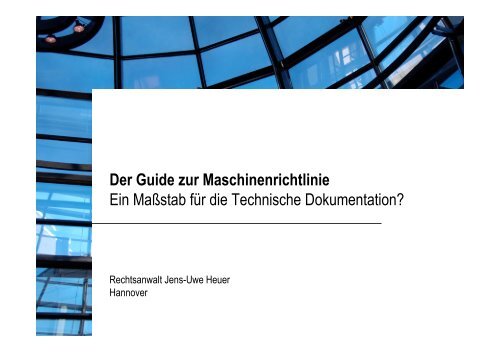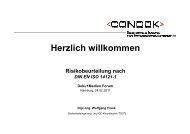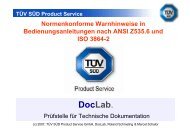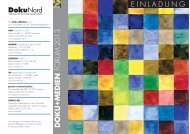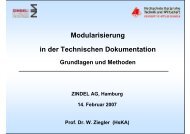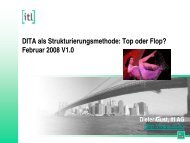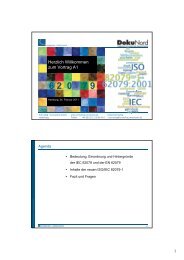Der Guide zur Maschinenrichtlinie Ein Maßstab für die Technische ...
Der Guide zur Maschinenrichtlinie Ein Maßstab für die Technische ...
Der Guide zur Maschinenrichtlinie Ein Maßstab für die Technische ...
Erfolgreiche ePaper selbst erstellen
Machen Sie aus Ihren PDF Publikationen ein blätterbares Flipbook mit unserer einzigartigen Google optimierten e-Paper Software.
<strong>Der</strong> <strong>Guide</strong> <strong>zur</strong> <strong>Maschinenrichtlinie</strong><br />
<strong>Ein</strong> <strong>Maßstab</strong> <strong>für</strong> <strong>die</strong> <strong>Technische</strong> Dokumentation?<br />
Rechtsanwalt Jens-Uwe Heuer<br />
Hannover
<strong>Ein</strong>leitung
<strong>Guide</strong> <strong>zur</strong> <strong>Maschinenrichtlinie</strong> - Hintergründe<br />
Inkrafttreten der MRL 2006/42 zum 29.12.2009<br />
Uneinheitliche Auslegung der MRL 98/37<br />
Bedürfnis nach einem Leitfaden vorhanden<br />
Kein Alleingang mehr; Schaffung einer „editorial group“<br />
<strong>Ein</strong>beziehung von Marktüberwachung und Industrie<br />
Begleitung durch das „machinery committee“<br />
Schaffung einer einheitlichen Praxis der MRL-Anwendung
<strong>Guide</strong> <strong>zur</strong> <strong>Maschinenrichtlinie</strong> - Zukunft<br />
Veröffentlichung einer deutschen Übersetzung<br />
Englische Fassung des <strong>Guide</strong> bleibt maßgeblich<br />
2. Auflage Juni 2010; 3. Auflage Ende 2011<br />
Selbstverpflichtung <strong>zur</strong> regelmäßigen Überwachung<br />
<strong>Ein</strong>bindung der Redaktion in <strong>die</strong> laufenden Diskussionen
WARNUNG!<br />
Die folgenden, kursiv hervorgehobenen<br />
Schriftstellen sind nicht gutbergliche<br />
Auffassung des Vortragenden, sondern<br />
geben entsprechende Textstellen des<br />
„<strong>Guide</strong>“ wieder.
<strong>Technische</strong> Dokumentation im Unternehmen
§ 244:<br />
Information, warnings and instructions about residual<br />
risks concern the third step of the three-step method set<br />
out in section 1.1.2 on the principles of safety integration.<br />
The fact that this third step is the last in the order of<br />
priority implies that warnings and instructions must not<br />
be a substitute for inherently safe design measures and<br />
integrated protective measures when these are possible,
Schlussfolgerungen:<br />
<strong>Technische</strong> Dokumentation ist eine Teil der Konstruktion<br />
<strong>Ein</strong>bindung in der Prozess „integrative Sicherheit“ erforderlich<br />
Entsprechende Gestaltung des Prozesses ist zu zeigen<br />
Information, Instruktion und Warnung sind Gesamtkonzept<br />
Organisationsverantwortung der Geschäftsleitung<br />
Anmerkung: 9. GPSGV – Fehlen der Anleitung = Bußgeld
… und <strong>die</strong> Realität?<br />
Risikoanalysen sind ein Fremdwort in der Konstruktion<br />
Üblich: Risikoanalyse und Sicherheitskonzept im nachhinein<br />
Fehlende Risikoanalysen problematisch bei Marktüberwachung<br />
<strong>Technische</strong> Dokumentation ist häufig nicht eingebunden<br />
Unklare Aufgabenteilung zwischen Doku und Konstruktion<br />
Warnhinweise an der Maschine durch <strong>die</strong> Konstruktion
Dokumentation im Zulieferprozeß
§ 390<br />
The assembly instructions shall deal with all safetyrelated<br />
aspects of the partly completed machinery and of<br />
the interface between the partly completed machinery and<br />
the final machinery which have to be considered by the<br />
assembler when incorporating the partly completed<br />
machinery into the final machinery.
§ 390<br />
In some cases, the manufacturer of the partly completed<br />
machinery may apply and fulfil the EHSRs relating to<br />
instructions set out in Annex I and state this in his<br />
Declaration of Incorporation. In other cases, the<br />
assembly instructions for partly completed machinery<br />
shall provide the necessary information relating to the<br />
partly completed machinery to enable the manufacturer of<br />
the final machinery to draft the parts of the instructions<br />
relating to the partly completed machinery.
§ 390<br />
This means that, where the manufacturer of the final<br />
machinery is known to the manufacturer of the partly<br />
completed machinery, the language of the assembly<br />
instructions provided with the partly completed<br />
machinery can be agreed between the two parties, for<br />
example, in the contract of sale. Where there is no such<br />
agreement, the assembly instructions must be provided in<br />
the official EU language(s) of the Member State in which<br />
manufacturer of the final machinery is established since<br />
that manufacturer cannot be presumed to understand<br />
another language.
Schlußfolgerungen:<br />
Inhalt der Anleitung im Zulieferverhältnis einzelfallabhängig<br />
Keine präzisen Vorgaben <strong>für</strong> Montageanleitung an sich<br />
Betonung der Erforderlichkeit vertraglicher Absprachen<br />
Keine Montageanleitung bei vollständigen Maschinen<br />
Vertragliche Vorgaben mit beachten<br />
Vorgaben aus dem Produkthaftungsrecht<br />
Geändertes GPSG: Zulieferteil als Produkt
… und <strong>die</strong> Realität?<br />
Möglichkeit zu vertraglichen Absprachen wird nicht genutzt<br />
Zulieferer und Endhersteller fühlen sich beide „im Recht“<br />
Unklarheiten und Reibungsverluste in der Praxis<br />
<strong>Ein</strong>stieg in den Dialog bzgl. der Doku dringend erforderlich<br />
Abgestuftes Dokumentationskonzept <strong>für</strong> <strong>die</strong> Zulieferung sinnvoll
Schriftform oder elektronische Form?
§255<br />
Section 1.7.4 does not specify the form of the instructions.<br />
It is generally agreed that all health and safety related<br />
instructions must be supplied in paper form, since it<br />
cannot be assumed that the user has access to the means<br />
of reading instructions supplied in electronic form or<br />
made available on an Internet site. However, it is often<br />
useful for the instructions to be made available in<br />
electronic form and on the Internet as well as in paper<br />
form, since this enables the user to download the<br />
electronic file if he so wishes and to recover the<br />
instructions if the paper copy has been lost.
Schlussfolgerungen:<br />
Elektronische Dokumentation unzulässig <strong>für</strong> Sicherheitsinfo<br />
Inhalte aus Anhang I, Ziffer 1.7.4., nicht sicherheitsrelevant?<br />
Formale Anforderungen (+); Inhalte Anforderung (-)<br />
Ergebnis: gesamt Anleitung nach Anhang I, Ziffer 1.7.4 = Papier<br />
Identisches Ergebnis auf Grundlage der Produkthaftung<br />
Identisches Ergebnis auf Grundlage des Vertragsrechts
… und <strong>die</strong> Realität?<br />
verbissener „Kampf um das Papier“<br />
ökonomische Erwägungen sind rechtlich irrelevant!<br />
Fragestellung „Papier oder CD“ geht am Kern vorbei<br />
Prüfung des Umfangs des Dokumentation erforderlich<br />
Phantasie bei der Informationsdarbietung<br />
Entschlackung durch <strong>die</strong> Konstruktion<br />
Mögliche neue Entwicklung durch „elektronisches Papier“
Übersetzungsverpflichtung?
§ 256<br />
As a general rule, all health and safety related<br />
instructions must be supplied in the official EU language<br />
or languages of the Member State in which it is placed on<br />
the market and/or put into service – see §246: comments<br />
on section 1.7.1.<br />
The second paragraph of section 1.7.4 should be<br />
understood in light of section 1.7.4.1. Machinery must be<br />
accompanied by original instructions, that is to say,<br />
instructions verified by the manufacturer or his<br />
authorised representative.
§ 257<br />
Paragraph (b) of section 1.7.4.1 deals with the situation<br />
where machinery is placed on the market in a Member<br />
State for which the manufacturer or his authorised<br />
representative has not prepared original instructions.<br />
This may occur, for example, if an importer, a distributor<br />
or a user takes the initiative to place the machinery on the<br />
market or put it into service in a Member State not<br />
initially foreseen by the manufacturer. In such cases, a<br />
translation … must be provided by the manufacturer or<br />
his authorised representative or by the person bringing<br />
the machinery into the language area in question.
Schlussfolgerungen:<br />
Übersetzungsverpflichtung in Bezug auf <strong>die</strong> Anleitung<br />
Grundmuster: Original in der Sprache des Nutzerlandes<br />
Original in Nutzerlandsprache genügt<br />
Falls kein „Original“, dann erst Erfordernis der Übersetzung<br />
Kennzeichnung der Übersetzung erforderlich
… und <strong>die</strong> Realität?<br />
Beifügung von zwei Sprachfassungen<br />
Deutsche Hersteller schreiben in deutscher Sprache<br />
Haftung auch <strong>für</strong> <strong>die</strong> Übersetzung wird häufig übersehen<br />
Übersetzung auch bei Kleinstauflagen<br />
Vertragliche Gestaltung in Bezug auf Kosten/Übersetzung<br />
Verbissener Kampf um <strong>die</strong> Übersetzung<br />
Übersetzung = Ansatz <strong>zur</strong> Dokuverschlankung
Vorhersehbarer Fehlgebrauch?
§258<br />
Paragraph (c) of section 1.7.4.1 underlines that the<br />
instructions are one of the means for preventing the<br />
misuse of machinery. This implies that when drafting<br />
instructions on each of the aspects listed in section<br />
1.7.4.2, manufacturers must take account of knowledge<br />
about how the machinery is liable to be misused, in the<br />
light of experience of past use of similar machinery,<br />
accident investigations and knowledge about readily<br />
predictable human behaviour.
§263<br />
Section 1.7.4.2 (h) requires the manufacturer's<br />
instructions to provide warnings against reasonably<br />
foreseeable misuse of the machinery ... To avoid such<br />
misuse, it is helpful to indicate to the user the usual<br />
reasons for such misuse and to explain the possible<br />
consequences. The warnings against reasonably<br />
foreseeable misuse of the machinery should take account<br />
of feedback from users and information about accidents<br />
or incidents involving similar machinery.
Schlussfolgerungen:<br />
Berücksichtung des vorhersehbare Fehlgebrauchs<br />
Abstellen auf das „vernünftigerweise“ vorhersehbar<br />
Berücksichtigung durch einen entsprechenden Hinweis<br />
Hersteller muss sich reale Kenntnisse verschaffen<br />
Instrument <strong>zur</strong> Klärung ist <strong>die</strong> Produktbeobachtung<br />
Anforderung auch aus der Produkthaftung heraus
… und <strong>die</strong> Realität?<br />
Fehlgebrauch wird häufig „erraten“<br />
Produktbeobachtung findet nicht statt<br />
Berücksichtigung der Fehlgebrauchs erfolgt nicht<br />
Häufig zu weitschweifende Formulierung<br />
Abstimmung mit Marketing und Verkaufsmaterialien
Hinweise <strong>zur</strong> Wartung von Produkten
§ 272:<br />
In particular, the instructions must specify the adjustment<br />
and maintenance operations that must be carried out and<br />
indicate their frequency. The instructions must list the<br />
elements or parts of the machinery that must be regularly<br />
checked in order to detect excessive wear, the periodicity<br />
of these checks (in terms of duration of use or number of<br />
cycles), the nature of the necessary inspections or tests<br />
and the equipment to be used. Criteria must be given for<br />
the repair or replacement of worn parts – see §207:<br />
comments on section 1.3.2.
Schlussfolgerungen:<br />
Hinweise zu Wartung der Maschine erforderlich<br />
Wartung als kontinuierliche Behandlung<br />
Hinweise <strong>für</strong> <strong>die</strong> Fehlersuche<br />
Informationen über <strong>die</strong> Ersatzteile<br />
Informationen über Sonderwerkzeuge
… und <strong>die</strong> Realität?<br />
Hersteller halten Informationen über <strong>die</strong> Wartung <strong>zur</strong>ück<br />
Ersatzteilbeschaffung als „Geheimwissenschaft“<br />
Kunde soll nicht „ an der Maschine herumarbeiten“<br />
Interessenkollision mit dem „Aftersales-Geschäft“<br />
Anforderung aus der Produkthaftung wird nicht gesehen
Dokumentation und Verkaufsliteratur
§ 275<br />
While the instructions provided with the machinery are<br />
primarily intended to ensure safe use of the machinery,<br />
sales literature has a principally commercial function.<br />
However section 1.7.4.3 requires that the instructions and<br />
commercial documents relating to the machinery be<br />
consistent. This is particularly important with respect to<br />
the intended use of the machinery referred to in section<br />
1.7.4.2 (g), since users are likely to choose machinery for<br />
their purposes on the basis of sales literature.
Schlussfolgerungen:<br />
Konsistenz von Anleitung und Verkaufsliteratur<br />
Wechselwirkung; Beeinflussung des „Fehlgebrauchs“<br />
Hohe Bedeutung von Verkaufsliteratur<br />
Hohe Bedeutung der Anleitung
… und <strong>die</strong> Realität?<br />
Konflikt <strong>Technische</strong> Dokumentation und Marketing<br />
Beschönigende Darstellungen in Marketing-Unterlagen<br />
Unterschiedliche Revisionsstände<br />
Missachtung der Haftung <strong>für</strong> Werbeaussagen
Referent<br />
Jens-Uwe Heuer<br />
Rechtsanwalt, Hannover<br />
Partner von Herfurth & Partner<br />
Rechtsanwaltsgesellschaft mbH, Hannover<br />
www.herfurth.de<br />
HERFURTH & PARTNER<br />
RECHT INTERNATIONAL.
COPYRIGHT BY<br />
HERFURTH & PARTNER<br />
RECHTSANWALTS-<br />
GESELLSCHAFT MBH<br />
HANNOVER<br />
GÖTTINGEN<br />
BRÜSSEL<br />
LUISENSTR. 5<br />
30159 HANNOVER<br />
FON 0511 307 56-0<br />
FAX 0511 307 56-10<br />
info@herfurth.de<br />
www.herfurth.de<br />
MEMBER OF<br />
ALLIURIS GROUP<br />
ALLIANCE OF<br />
INTERNATIONAL<br />
BUSINESS LAWYERS<br />
BRUSSELS<br />
AMERSFOORT<br />
LUXEMBOURG<br />
LONDON<br />
PARIS<br />
LYON<br />
MADRID<br />
BILBAO<br />
MALAGA<br />
ALICANTE<br />
LISBON<br />
MILAN<br />
HANOVER<br />
ZUG<br />
VIENNA<br />
POZNAN<br />
BRATISLAVA<br />
SOFIA<br />
ISTANBUL<br />
DUBAI<br />
NEW DELHI<br />
HERFURTH & PARTNER<br />
RECHT INTERNATIONAL.


